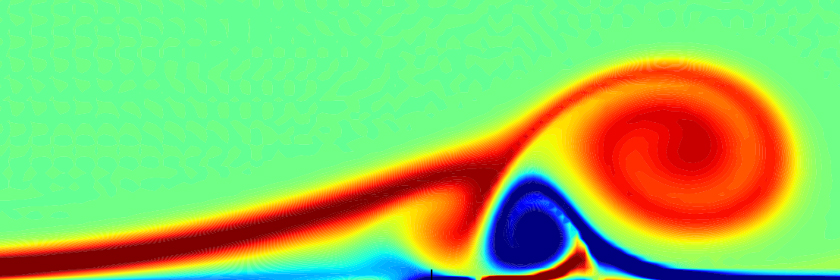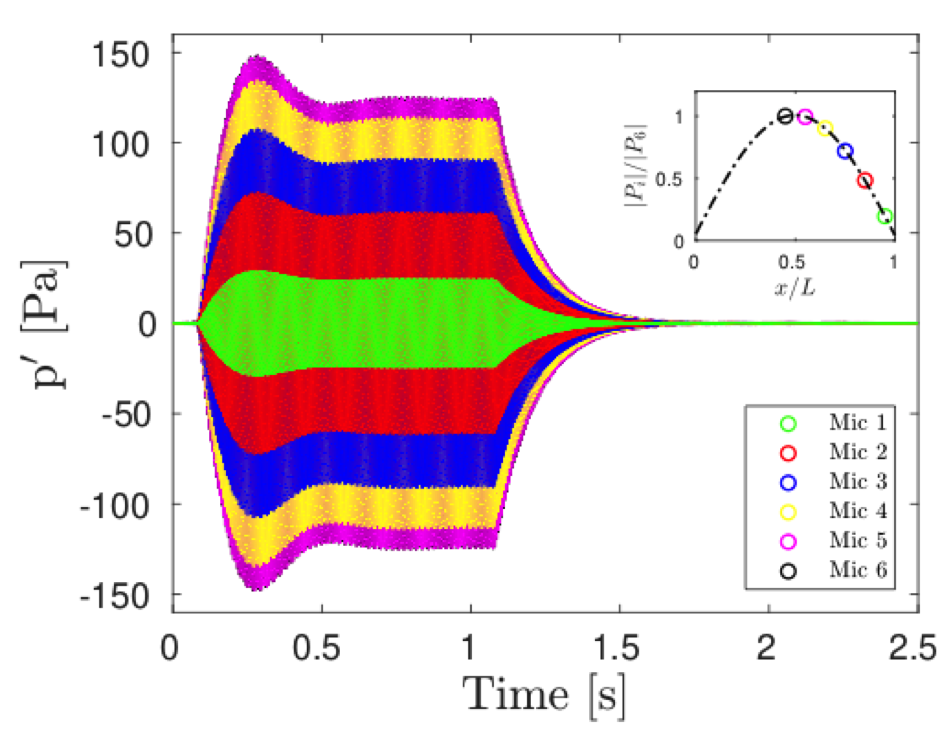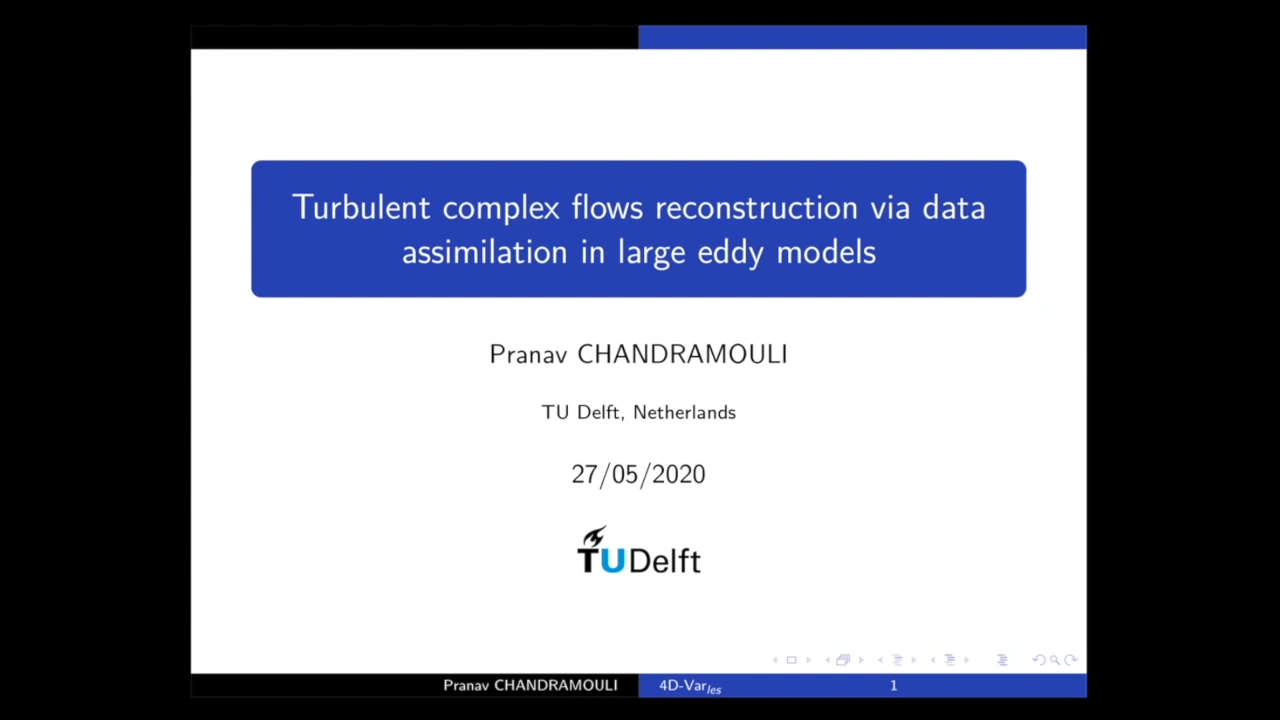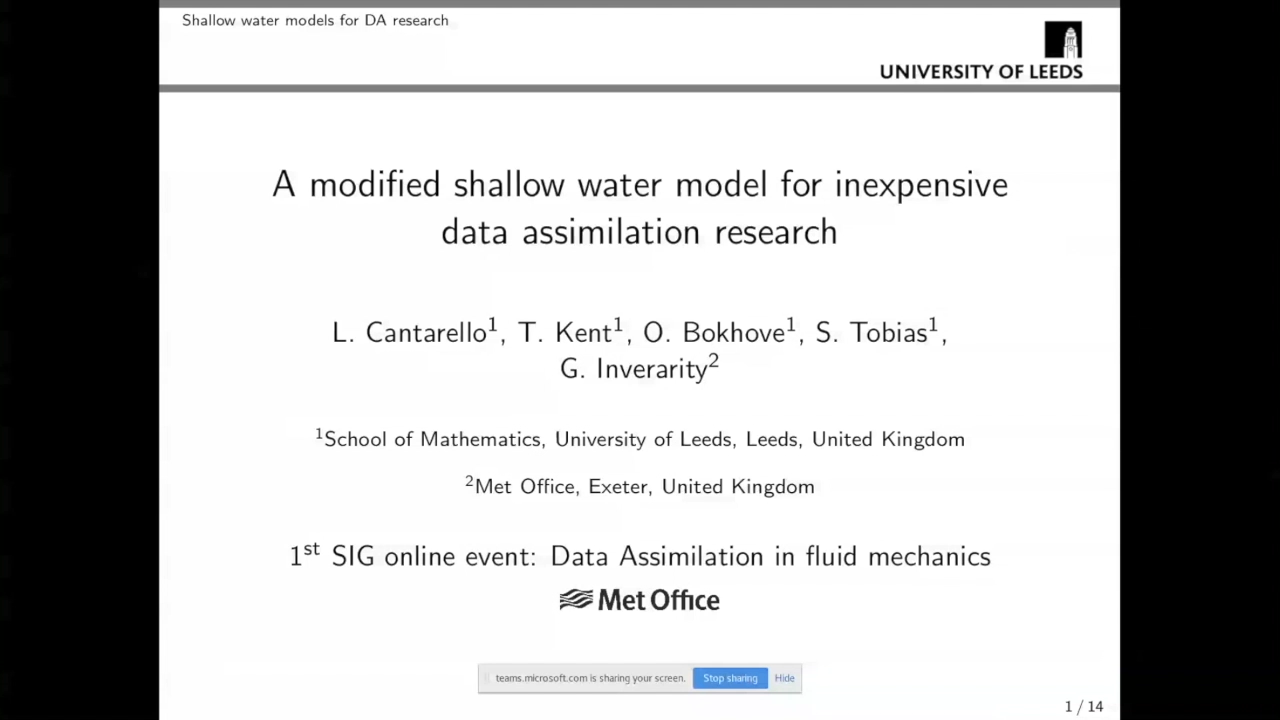Flow instability, modelling and control
Description
The SIG specialises in fluid flow transition and control: hydrodynamic stability, coherent structures and nonlinear dynamics, modelling, simulation, experiments and development of novel flow control strategies. The SIG aims at facilitating communication and collaboration for emerging challenges, training of next-generation researchers, and an increased international visibility of the UK’s research activities in this area. The SIG members consist of leading figures in established (flow instability) and emerging areas (dynamical systems, flow control, optimisation) from both academia and industry (Airbus, Rolls-Royce & Mclaren), and their expertise covers all the technical aspects (theory, computation and experiments). The scope of the SIG is: 1) to improve communication across boundaries between traditional and emerging areas; 2) to foster the next generation of academics and industrial researchers at the subject interface; 3) to collectively correspond to research council funding initiatives; 4) to increase the international visibility of the UK’s research activities in the areas of the SIG.
Join SIG Mailing list
Members
L = leader; C = co-leader; * = Other key personnel
| Yongyun Hwang ( Imperial College London ): | |
| Ati Sharma ( University of Southampton ): | |
| Paolo Adami ( Rolls-Royce ): | |
| Anurag Agarwal ( University of Cambridge ): | |
| Evangelia Antonopoulou ( University of Leeds ): | |
| Richard Ashworth ( Airbus ): | |
| Chris Atkin ( City University ): | |
| Dwight Barkley ( University of Warwick ): | |
| Andrea Cassinelli ( Imperial College London ): | |
| Colm-cille Caulfield ( University of Cambridge ): | |
| Sergei Chernyshenko ( Imperial College London ): | |
| Stephen Cowley ( University of Cambridge ): | |
| John Craske ( Imperial College London ): | |
| David Dennis ( University of Liverpool ): | |
| Bharath Ganapathisubramani ( University of Southampton ): | |
| Stephen Garrett ( University of Leicester ): | |
| Mike Gaster ( City University ): | |
| Jonathan Healey ( Keele University ): | |
| Richard Hewitt ( University of Manchester ): | |
| Julien Hoessler ( McLaren ): | |
| Zahir Hussain ( University of Leicester ): | |
| Matthew Juniper ( University of Cambridge ): | |
| Richard Kerswell ( University of Cambridge ): | |
| [C] | Davide Lasagna ( University of Southampton ): davide.lasagna@soton.ac.uk |
| Rebecca Lingwood ( Brunel University London ): | |
| Rob Long ( University of Leeds ): | |
| Xuerui Mao ( University of Nottingham ): | |
| Nick Martin ( Northumbria University ): | |
| Andrew McMullan ( University of Leicester ): | |
| Jonathan Morrison ( Imperial College London ): | |
| [L] | George Papadakis ( Imperial College London ): g.papadakis@imperial.ac.uk |
| Nigel Peake ( University of Cambridge ): | |
| Pierre Ricco ( University of Sheffield ): | |
| Anatoly Ruban ( Imperial College London ): | |
| Neil Sandham ( University of Southampton ): | |
| Shahrokh Shahpar ( Rolls-Royce ): | |
| Spencer Sherwin ( Imperial College London ): | |
| Frank Smith ( University College London ): | |
| Steve Tobias ( University of Edinburgh ): | |
| Owen Tutty ( University of Southampton ): | |
| Christina Vanderwel ( University of Southampton ): | |
| Ashley Willis ( University of Sheffield ): | |
| Xuesong Wu ( Imperial College London ): | |
| [C] | Georgios Rigas ( Imperial College London ): g.rigas@imperial.ac.uk |
| Sean Symon ( University of Southampton ): | |
| Moritz Linkmann ( University of Edinburgh ): | |
| Junho Park ( Coventry University ): | |
| Jacob Page ( University of Edinburgh ): | |
| Abhishek Kumar ( Coventry University ): | |
| Anirban Guha ( University of Dundee ): | |
| Mohaddeseh Mousavi Nezhad ( University of Warwick ): | |
| Katarzyna Kowal ( University of Glasgow ): | |
| [C] | Elena Marensi ( University of Sheffield ): e.marensi@sheffield.ac.uk |
| Mark Jabbal ( University of Nottingham ): | |
| Benjamin Bugeat ( University of Leicester ): | |
| Fabio Pino ( University of Cambridge ): |
Upcoming Meetings
3rd SIG Meeting -- Imperial College London on 19th April 2024.
Important dates
Abstract submission now closed
Notification of acceptance – 19/03/2024
The full programme is available here.
The event will be held in-person and registration is free of charge, but you will have to cover your travel, accommodation (if needed) and food expenses.
The event will be held in room 300 of the City and Guilds Building (CAGB) with refreshments provided in the ground floor foyer of the building. For lunch, you are welcome to use any of the several nearby venues on campus and around the college.
If you wish to attend please contact Elena Marensi (e.marensi@sheffield.ac.uk).
Invited talk
Prof. Valerio Lucarini, University of Leicester (v.lucarini@leicester.ac.uk)
Professor of Applied Mathematics in the School of Computing and Mathematical Sciences
Title: Advancing our knowledge on the climate crisis by combining response theory and Koopmanism.
Abstract: For systems near thermodynamic equilibrium, the classical fluctuation-dissipation theorem provides a powerful framework for relating forced and and free variability. By collecting sufficient statistics on the unperturbed system, we can predict its (linear) response to forcings. Things become considerably more challenging when studying general nonequilibrium systems, which are in fact ubiquitous in a multitude of applications. I will first discuss how using a more general form of response theory it is possible to perform climate change projections using climate models of different level of complexity, ranging from conceptual to fully-blown Earth System Models. I will then show how combining such theoretical framework with Koopmanism one can find a) a decomposition of the response operator as a sum of interpretable terms, each associated with a mode of variability of the system and b) develop a general theory of critical transitions in complex system and identify the critical mode associated with the loss of stability of a reference state. This perspective is extremely promising as it combines theoretical clarity with clear connections with much studied and developed data-driven methods.
Refs:
V. Lucarini and M. Chekroun, Theoretical tools for understanding the climate crisis from Hasselmann’s programme and beyond. Nat. Rev. Phys. (2023) doi: 10.1038/s42254-023-00650-8
M. Santos Gutiérrez and V. Lucarini, On some aspects of the response to stochastic and deterministic forcings, J. Phys. A: Math. Theor. 55 425002 (2022)
M. Ghil and V. Lucarini, The Physics of Climate Variability and Climate Change, Rev. Mod. Phys. 92, 035002 (2020)
Previous Meetings
2nd SIG Online Event: Nonlinear Stability Analysis and Modelling - Sep 15, 2020 (Eventbrite, Abstracts)
1st SIG Online Event: Data Assimilation in Fluid Mechanics - May 27, 2020 (Eventbrite, Abstracts)
11th International Symposium on Turbulent Shear Flow Phenomena 30, July - 2, August 2019, Grand Harbour Hotel, Southampton
IUTAM Symposium on Transition 2-6 Sep 2019, Imperial College London
EPSRC Summer School on Modal Decompositions in Fluid Mechanics 5-8 Aug 2019, DAMTP, University of Cambridge
SIG Meeting 28 Aug 2018, Imperial College London (Programme)
Euromech Colloquium 598 29-31 Aug 2018, Imperial College London
1st SIG Meeting 28-30 Mar 2017, University of Southampton (Abstract)
1st SIG Online Event: Data Assimilation in Fluid Mechanics
Date: 27 May 2020
Plenary Talk
Denis Sipp (ONERA, France): Reconstruction of time-averaged and unsteady data in open-flows using non-linear optimization techniques and hydrodynamic stability
Talks
Luca Magri (Cambridge) Overview of data assimilation: Variational methods vs Statistical learning
Matthew Juniper, (Cambridge) Hans Yu, Francesco Garita, Luca Magri. Assimilation of 100,000 experimental datapoints of a thermoacoustic instability: turning a qualitative model into a quantitative model.
Pranav Chandramouli (TU Delft): 4D Variational assimilation of wake flow with a dynamics error model
Luca Cantarello (Leeds): A modified shallow water model for inexpensive data assimilation research
Yongyun Hwang (Imperial College) & Bruno Eckhardt: An optimisation-based quasi-linear approximation for linearly stable shear flows: application to turbulent channel flow up to Re_tau=20,000.
Detailed abstracts (PDF)
Organisers
George Papadakis (Imperial College)
Georgios Rigas (Imperial College)
Davide Lasagna (Southampton)
Xuerui Mao (Nottingham)
2nd SIG Online Event: Nonlinear Stability Analysis and Modelling
Date: 15 Sep 2020
Plenary Talks
Steve Tobias (Leeds). Generalised Quasilinear Modelling of the interaction of shear and convection.
Francois Gallaire (EPFL). Too big to grow: saturation mechanisms in open flows.
Talks
Yacine Bengana (CNRS ESPCI Sorbonne). Frequency prediction from exact or self-consistent mean flows in thermosolutal convection.
Sean Symon (Southampton). A nonlinear energy transfer perspective on reduced-order modelling tools.
Georgios Rigas (Imperial College). Nonlinear input/output analysis: application to boundary layer transition.
Edouard Boujo (EPFL). Second-order adjoint-based sensitivity for hydrodynamic stability and control.
Giovanni Fantuzzi (Imperial College). Bounding nonlinear amplification of energy and other quantities with convex optimization.
Publications
Beer J., Tobias S.M. & Weiss N.O. 2018, On long-term modulation of the Sun’s magnetic cycle, Monthly Notices of the Royal Astronomical Society, 473, pp. 1596–1602.
Ghirardo G., Juniper M.P. & Bothien M.R. 2018, The effect of the flame phase on thermoacoustic instabilities, Combustion and Flame, 187, pp. 165-184.
Goldstein M.E. & Ricco P. 2018, Non-localized instabilities resulting from leading-edge receptivity at moderate supersonic Mach numbers, Journal of Fluid Mechanics, 848, pp. 435-477.
Kuhnen J., Song B., Scarselli D., Budanur, N.B., Riedl M., Willis A.P., Avila M. & Hof B. 2018, Destabilizing turbulence in pipe flow, Nature Physics, ISSN 1745-2473.
Yang Q., Willis A.P. &; Hwang, Y. 2018, Energy production and self-sustained turbulence at the Kolmogorov scale in Couette flow. Journal of Fluid Mechanics, 834, pp. 531-554.
Aguilar J.G., Magri L. & Juniper M.P. 2017, Adjoint-based sensitivity analysis of low-order
thermoacoustic networks using a wave-based approach, Journal of Computational Physics
341, pp. 163-181.
Al-Tameemi W.T.M. & Ricco P. 2017, Pattern-based pressure drop of air-water flow across a 90 sharp miter elbow, International Journal of Computational Methods and Experimental Measures, 6, pp. 198-207.
Budanur N.B., Short K.Y, Farazmand M., Willis A.P. & Cvitanović, P. 2017, Periodic orbits form the backbone of turbulent pipe flow, Journal of Fluid Mechanics, 833, pp. 274-301.
Calkins M.A., Julien K. & Tobias S.M. 2017 Inertia-less convectively-driven dynamo models in the limit of low Rossby number and large Prandtl number, Physics of the Earth and Planetary Interiors, 266, pp. 54-59.
Cassinelli A., de Giovanetti M. & Hwang Y. 2017, Streak instability in near-wall turbulence revisited, Journal of Turbulence, 18, pp. 443-464.
Cossu C. & Hwang Y. 2017, Self-sustaining process at all scales in wall-bounded turbulent shear flows, Philosophical Transactions of the Royal Society A, 375, 20160088.
Craske J. 2017, The properties of integral models for planar and axisymmetric unsteady jets, IMA Journal of Applied Mathematics, 82, pp. 305-333.
Craske J., Salizzoni P. & van Reeuwijk M. 2017, The turbulent Prandtl number in a pure plume is 3/5, Journal of Fluid Mechanics, 822, pp. 774-790.
Deng J., Xue J., Mao X. & Caulfield C. 2017, Coherent structures in interacting vortex rings, Physical Review Fluids, 2, 022701.
de Giovanetti M., Sung H.J. & Hwang Y. 2017, Streak instability in turbulent channel flow: a seeding mechanism of large-scale motions, Journal of Fluid Mechanics, 832, pp. 483-513.
Griffiths P.T., Garrett S.J., Stephen S.O. & Hussain Z. 2017, Quantifying non-Newtonian effects in rotating boundary-layer flows, European Journal of Mechanics B/Fluids, 61, pp. 304-309.
Grimble T., Agarwal A. & Juniper M.P. 2017, Local linear stability analysis of cyclone separators, Journal of Fluid Mechanics, 816, pp. 507-538.
Guseva A., Hollerbach R., Willis A.P. & Avila M. 2017, Azimuthal magnetorotational instability at low and high magnetic Prandtl numbers, Magnetohydrodynamics, 53, pp. 25-34.
Guseva A., Hollerbach R., Willis A.P. & Avila M. 2017, Dynamo action in a quasi-Keplarian Taylor-Couette flow, Physical Review Letters, 119, 164501.
Guseva A., Willis A.P., Hollerbach R. & Avila M. 2017, Transport properties of the azimuthal magnetorotational instability, The Astrophysical Journal, 849, 92.
Hussain Z. 2017, Competing instabilities of rotating boundary-layer flows in an axial free-stream, European Journal of Mechanics B/Fluids, 61, pp. 316-320.
Jamieson N. & Juniper M.P. 2017, Experimental sensitivity analysis of a linearly stable thermoacoustic system via a pulsed forcing technique, Experiments in Fluids, 58, pp. 123-134.
Jamieson N., Rigas G. & Juniper M.P. 2017, Experimental sensitivity analysis via a secondary heat source in an oscillating thermoacoustic system, International Journal of Spray and Combustion Dynamics, 9, pp. 230-240.
Kent T., Bokhove O. & Tobias S. 2017, Dynamics of an idealized fluid model for investigating convective-scale data assimilation. Tellus A: Dynamic Meteorology and Oceanography, 69, 1369332.
Mao X. & Hussain F. 2017, Optimal transient growth on a vortex ring and its transition via cascade of ringlets, Journal of Fluid Mechanics, 832, pp. 269-286.
Mao X., Zaki T., Sherwin S. & Blackburn H. 2017, Transition induced by linear and nonlinear perturbation growth in flow past a blade, Journal of Fluid Mechanics, 820, pp. 604-632.
Marensi E. & Ricco P. 2017, Growth and wall-transpiration control of nonlinear unsteady Gortler vortices forced by free-stream vortical disturbances, Physics of Fluids, 29 114106.
Marensi E., Ricco P. & Wu X. 2017 Nonlinear unsteady streaks engendered by the interaction of free-stream vorticity with a compressible boundary layer, Journal of Fluid Mechanics, 817, pp. 80-121.
Márquez-Artavia X., Jones C.A. & Tobias S.M. 2017, Rotating magnetic shallow water waves and instabilities in a sphere, Geophysical and Astrophysical Fluid Dynamics, 111 (4), pp. 282-322.
Nigro G., Pongkitiwanichakul P., Cattaneo F. & Tobias S.M. 2017, What is a large-scale dynamo?, Monthly Notices of the Royal Astronomical Society, 464, pp. L119-L123.
Semlitsch B., Orchini A., Dowling A.P. & Juniper M.P. 2017, G-equation modelling of thermo-acoustic oscillations of partially-premixed flames, International Journal of Spray and Combustion Dynamics, 4, pp. 260-276.
Sharma A.S., Moarref R. & McKeon B.J. 2017, Scaling and interaction of self-similar modes in models of high-Reynolds number wall turbulence, Philosophical Transactions of the Royal Society A, 375(2089).
Sharma A.S., Theofilis V. & Colonius T. 2017, Special issue on global flow instability and control, Theoretical and Computational Fluid Dynamics, 31, pp. 471-474.
Tobias S.M. & Marston J.B. 2017, Direct statistical simulation of jets and vortices in 2D flows. Physics of Fluids, 29, 111111.
Tobias S.M. & Marston J.B. 2017, Three-dimensional rotating Couette flow via the generalised quasilinear approximation, Journal of Fluid Mechanics, 810 , pp. 412-428.
Wen C., Poole R.J., Willis A.P. & Dennis D.J.C. 2017, Experimental evidence of symmetry-breaking supercritical transition in pipe flow of shear-thinning fluids, Physical Review Fluids, 2, 031901.
Willis A.P. 2017, The Openpipeflow Navier-Stokes Solver, SoftwareX, 6, pp.124-127.
Willis A.P., Duguet Y., Omel'chenko O. & Wolfrum M. 2017, Surfing the edge: using feedback control to find nonlinear solutions, Journal of Fluid Mechanics, 831, pp. 579-591.





